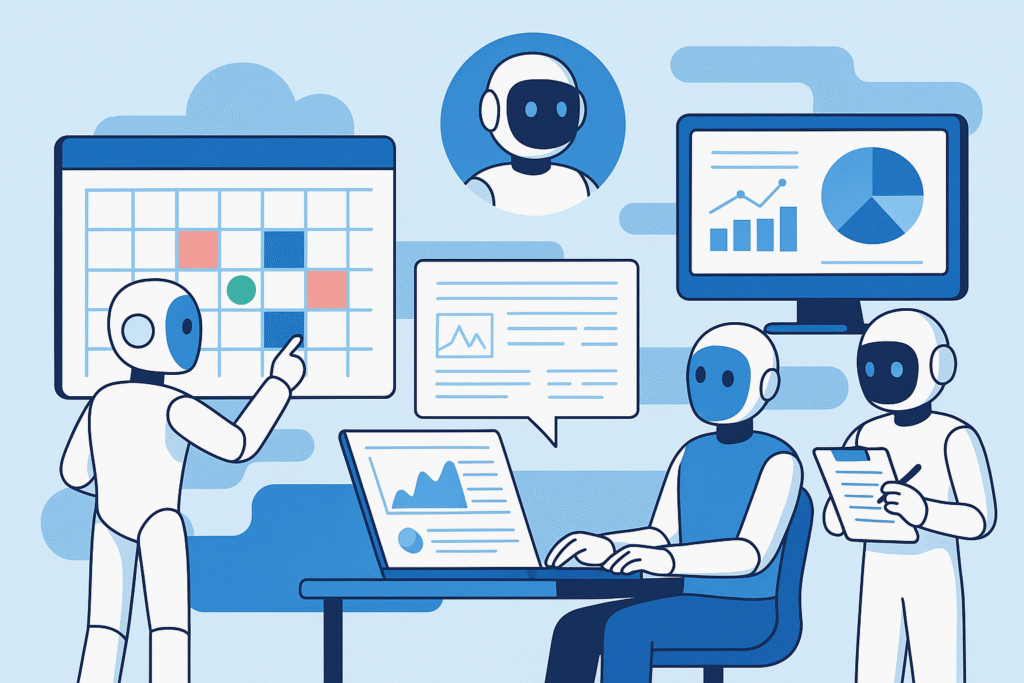
1. What Is Agentic AI? Reactive vs. Proactive Intelligence
Agentic AI describes systems that don’t just respond to user prompts—they act, plan, and execute tasks autonomously. Unlike “reactive” chatbots, agentic AI can initiate actions based on objectives and context. For example, it can independently book meetings or compose reports with minimal human oversight.
2. Microsoft’s Agentic Initiatives: AI Agents that Book, Write, Manage
Microsoft has incorporated agentic AI into its ecosystem—where AI agents can schedule meetings, draft reports, and assist project workflows within Microsoft 365. These agents move beyond suggestions, executing tasks like calendar coordination or document generation automatically. (While Microsoft hasn’t given a formal product name, the capability aligns with agentic evolution.)
3. Google’s Project Astra and Gemini-Powered Agents
Project Astra is Google’s prototype universal agent integrated into its Gemini Live interface. It processes voice, video, and image inputs—identifying objects, reading code, recalling prior observations, and even suggesting names for pets. It’s multimodal, remembers context over time, and works across Search, Lens, and Maps.
Gemini 2.0 and future Gemini models will power different agent modalities:
- Deep Research Agent: Builds multi-step research plans and comprehensive reports
- Mariner Agent: Simulates browser actions—clicking, form-filling, navigating websites.
4. OpenAI’s Next‑Gen Autonomous Agents: Operator, Agent, Super Agent
Operator
Released in early 2025 as a research preview in the U.S., Operator uses GPU‑4o plus reinforcement-learned reasoning with a browser interface. It sees the web like a human and interacts with GUIs—booking travel, shopping, ordering—while requesting user approval for sensitive actions like payments or logins.
ChatGPT Agent (“Agent”)
Launched July 17, 2025, built on GPT‑4o, this agent can browse live data, fill forms, and integrate with Gmail, Google Drive, GitHub, and more. It can plan and adapt workflows dynamically—automating entire job cycles from web search to emailing a report. Sam Altman emphasized its experimental nature and urged caution with sensitive actions.
Super Agent by Genspark
A no‑code, multimodal agent built with OpenAI’s GPT‑4.1 and Realtime API, Super Agent can make phone calls, generate pitch decks, and compose videos with voice‑to‑speech conversation. It grew to $36M in revenue within 45 days, showing real demand for outcome-focused agentic tools.
5. Real-World Cases: Agentic AI in Action
- Amarra (New Jersey): Uses ChatGPT AI for writing product descriptions (cutting time by 60%), inventory optimization reducing overstock by 40%, and chatbots handling 70% of customer inquiries in service and content roles.
- Comcast: Employs LLM-powered tools like “Ask Me Anything” enabling human agents to query AI in real time—reducing resolution time and boosting agent satisfaction.
- Vogue / Fashion Brands: LVMH and Diane von Furstenberg are exploring visible agentic agents for customer styling, supply chain forecasting, and campaign ideation. Internal “invisible intelligence” systems handle complex back-office workflows.
6. Reactive Chatbots vs Proactive Agentic Systems
Reactive chatbots follow rules or scripted flows—they wait for user prompts and reply accordingly. Agentic AI, however:
- initiates actions when needed (e.g. scheduling)
- perceives context over time
- interacts with external apps or web interfaces directly
- handles multi-step goals without constant, manual input.
7. Pros, Limitations & Security Considerations
Advantages:
- Significant time savings
- Multi-step workflow management
- Human-like autonomy for routine admin tasks
Limitations:
- Still experimental: struggles with complex UI, CAPTCHA, login auth
- Security concerns: sensitive tasks require user approval; critics warn of potential misuse and privacy risks
Best practices: keep humans in the loop, vet data privacy policies, roll out in stages focusing on low-risk areas first.
8. The Future of Work: Agentic AI as Virtual Coworkers
By 2025 and beyond, agentic AI is shifting from chatbot assistants to active collaborators. As Sam Altman noted, AI is becoming akin to a junior team member—helping discover new knowledge and contributing meaningfully to complex tasks.
Large enterprises are already adopting agentic AI for internal operations, customer engagement, and creative workflows. Early adopters are seeing efficiency gains, cost reductions, and faster execution—making agents virtual coworkers rather than simple bots.
FAQs
Q: How is agentic AI different from traditional chatbots?
A: Traditional chatbots are reactive—they wait for input and respond. Agentic AI can act independently, plan workflows, interact with external tools, and initiate tasks with minimal guidance.
Q: Are agentic AI tools safe to use?
A: Most current tools operate under strict user permissions. OpenAI and Google emphasize user control—requiring approvals for payments, logins, or high-risk actions.
Q: Which companies are already using agentic AI?
A: Examples include Amarra for content and inventory, Comcast for customer service-agent augmentation, and fashion brands like LVMH exploring both visible and internal agentic AI systems.
Q: When will agentic AI become mainstream?
A: It’s already in early use via previews and enterprise pilots (Operator, Astra, Super Agent). Widespread adoption is expected over the next few years as reliability and regulations mature.
Q: Should businesses switch to agentic AI now?
A: Start with low-risk workflows—customer service, content generation, small admin tasks—and iterate. Test with human oversight, refine rules, and scale once reliability and trust are established.
Final Thoughts on Agentic AI
Agentic AI is transforming how we think about digital assistants. Instead of just answering questions, virtual coworkers powered by agentic AI can work for you, taking initiative, managing complex workflows, and blending into the team dynamic. With powerful tools like OpenAI’s Agent and Google’s Astra, we’re witnessing the dawn of a new era in productivity and automation.


1 Comment